bio.wikisort.org - Animal
This is a list of dinosaurs whose remains have been recovered from North America. North America has a rich dinosaur fossil record with great diversity of dinosaurs.
History
The earliest potential record of dinosaurs in North America comes from rare, unidentified (possibly theropod) footprints in the Middle-Late Triassic Pekin Formation of North Carolina.[1] However, the most reliable early record of North American dinosaurs comes from fragmentary saurischian fossils unearthed from the Upper Triassic Dockum Group of Texas.[2] Later in the Triassic period, dinosaurs left more recognizable remains, and could be identified as specific genera. Examples of later Triassic North American dinosaur genera include Coelophysis, Chindesaurus, Gojirasaurus, and Tawa. Fossils of Tawa-like dinosaurs have also been found in South America, which has important indications about paleogeography. During the Early Jurassic Period, dinosaurs such as Dilophosaurus, Anchisaurus, Coelophysis (formerly known as Megapnosaurus), and the early thyreophoran Scutellosaurus lived in North America. The latter is believed to have been the ancestor of all stegosaurs and ankylosaurs. The Middle Jurassic is the only poorly represented time period in North America, although several Middle Jurassic localities are known from Mexico. Footprints, eggshells, teeth, and fragments of bone representing theropods, sauropods, and ornithopods have been found, but none of them are diagnostic to the genus level.
The Late Jurassic of North America, however, is the exact opposite of the Middle Jurassic. The Late Jurassic Morrison Formation is found in several U.S. states, including Colorado, Utah, Wyoming, Montana, New Mexico, Oklahoma, South Dakota, and Texas. It is notable as being the most fertile single source of dinosaur fossils in the world. The roster of dinosaurs from the Morrison is impressive. Among the theropods, Allosaurus, Saurophaganax, Torvosaurus, Ceratosaurus, Coelurus, Ornitholestes, Tanycolagreus, Stokesosaurus, and Marshosaurus are found in the Morrison. An abundance of sauropods has been found there, including Apatosaurus, Diplodocus, Barosaurus, Brachiosaurus, Camarasaurus, Brontosaurus and Amphicoelias. Three genera of stegosaurs, Alcovasaurus, Stegosaurus and Hesperosaurus, have been found there. Finally, ornithopods found in the Morrison include Camptosaurus, Dryosaurus, and Nanosaurus,
During the Early Cretaceous, new dinosaurs evolved to replace the old ones. Sauropods were still present, but they were not as diverse as they were in the Jurassic Period. Theropods from the Early Cretaceous of North America include dromaeosaurids such as Deinonychus and Utahraptor, the carnosaur Acrocanthosaurus, and the coelurosaur Microvenator. Sauropods included Astrodon, Brontomerus, and Sauroposeidon. Ornithischians were more diverse than they were in the Jurassic Period. Tenontosaurus, Dakotadon, Protohadros, and Eolambia are some of the ornithopods that lived during this time period. Ankylosaurs replaced their stegosaur cousins in the Cretaceous. Ankylosaurs from the Early Cretaceous of North America include Sauropelta and Gastonia. Therizinosaurs such as Falcarius are also known from the Early Cretaceous of North America.
Finally, during the Late Cretaceous Period, the greatest abundance and diversity of dinosaurs of all time lived in North America. During the early part of the Late Cretaceous, the therizinosaur Nothronychus and the ceratopsian Zuniceratops lived. During the Campanian stage of the Late Cretaceous, an enormous diversity of dinosaurs is known. Theropods included the tyrannosaurs Albertosaurus, Gorgosaurus, Daspletosaurus, Teratophoneus, Bistahieversor, and Appalachiosaurus, and the dromaeosaurids Dromaeosaurus, Saurornitholestes, Atrociraptor, and Bambiraptor. Ceratopsians, such as Pachyrhinosaurus, Styracosaurus, Centrosaurus, Monoclonius, Brachyceratops and Pentaceratops also existed. Among hadrosaurs, Hypacrosaurus, Gryposaurus, Kritosaurus, Parasaurolophus, Corythosaurus, Lambeosaurus and Prosaurolophus existed. During the latest Cretaceous, the Maastrichtian age, the diversity of dinosaurs saw a decline from the preceding Campanian stage. North American herbivorous dinosaurs from this time period include the titanosaur sauropod Alamosaurus, the ceratopsians Bravoceratops, Regaliceratops, Triceratops, Leptoceratops, Torosaurus, Nedoceratops, Tatankaceratops (the latter two possible species of Triceratops), and Ojoceratops, the pachycephalosaurs Pachycephalosaurus, Stygimoloch, Dracorex, and Sphaerotholus, the hadrosaurs Augustynolophus, Saurolophus and Edmontosaurus, the ornithopod Thescelosaurus the ankylosaur Ankylosaurus and the nodosaurs Denversaurus, Glyptodontopelta and Edmontonia. Predatory dinosaurs from this time period included the tyrannosaurids Tyrannosaurus, Nanotyrannus (which may just be a juvenile of the former) and Dryptosaurus, the ornithomimids Ornithomimus, Dromiceiomimus, Struthiomimus, the oviraptorids Anzu, Leptorhynchos and Ojoraptorsaurus, the troodontids Pectinodon, Paronychodon and Troodon, the coelurosaur Richardoestesia and the dromaeosaurs Acheroraptor and Dakotaraptor.
The only recorded find of a dinosaur fossil in Central America consists of a single femur discovered from Middle Cretaceous age deposits in Comayagua Department in the central part of Honduras. The fossil had been found in January, 1971 by Bruce Simonson and Gregory Horne, though it was later sent to the National Museum of Natural History, USA where it is deposited under catalogue number USNM PAL 181339. The discovery was not formally described until 1994 where it was identified as the femur of a small hadrosaur or iguanodontid, probably the former.[3] The first report of a dinosaur from Central America ever however was a newspaper article published in August of 1933 by Canada’s Montreal Gazette, though the story was picked up by several American newspapers. The fossil was an isolated metatarsus that had been collected by University of Pennsylvania explorer George Mason from woods near Olanchito, Honduras, though a vertebra was also mentioned to be found by locals. The bones have since been lost and their true identity remains indeterminable.[4]
Criteria for inclusion
- The creature must appear on the List of dinosaur genera.
- Fossils of the creature must have been found in North America.
- This list is a complement to Category:Dinosaurs of North America.
List of North American dinosaurs
Valid genera
| Name | Year | Formation | Location | Notes | Images |
|---|---|---|---|---|---|
| Abydosaurus | 2010 | Cedar Mountain Formation (Early Cretaceous, Albian) | ( |
Had a short domed crest on its skull similar to that of Giraffatitan | 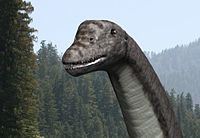 |
| Acantholipan | 2018 | Pen Formation (Late Cretaceous, Santonian) | ( |
Known to possess spike-like osteoderms | |
| Achelousaurus | 1994 | Two Medicine Formation (Late Cretaceous, Campanian) | ( |
Combines long spikes on the top of its frill and a low keratinous boss over its eyes and nose | 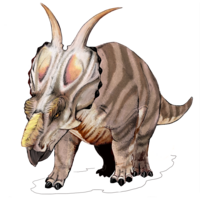 |
| Acheroraptor | 2013 | Hell Creek Formation (Late Cretaceous, Maastrichtian) | ( |
One of the geologically youngest dromaeosaurids |  |
| Acristavus | 2011 | Two Medicine Formation, Wahweap Formation (Late Cretaceous, Campanian) | ( |
Uniquely for a hadrosaurid, it lacked any ornamentation on its skull |  |
| Acrocanthosaurus | 1950 | Antlers Formation, Cloverly Formation, Twin Mountains Formation (Early Cretaceous, Aptian to Albian) | ( |
Possessed elongated neural spines that would have supported a low sail or hump in life |  |
| Acrotholus | 2013 | Milk River Formation (Late Cretaceous, Santonian) | ( |
Had a tall, oval-shaped dome |  |
| Adelolophus | 2014 | Wahweap Formation (Late Cretaceous, Campanian) | ( |
Potentially a basal member of the Parasaurolophini[5] |  |
| Agujaceratops | 2006 | Aguja Formation (Late Cretaceous, Campanian) | ( |
The type species was originally assigned to the genus Chasmosaurus |  |
| Ahshislepelta | 2011 | Kirtland Formation (Late Cretaceous, Campanian) | ( |
Relatively small for an ankylosaur |  |
| Akainacephalus | 2018 | Kaiparowits Formation (Late Cretaceous, Campanian) | ( |
Much of the skeleton is known, including the entirety of the skull |  |
| Alamosaurus | 1922 | Black Peaks Formation, El Picacho Formation, Javelina Formation, North Horn Formation, Ojo Alamo Formation (Late Cretaceous, Maastrichtian) | ( |
One of the largest dinosaurs known from North America[6] |  |
| Alaskacephale | 2006 | Prince Creek Formation (Late Cretaceous, Campanian to Maastrichtian) | ( |
Had an array of polygonal nodes on its squamosal |  |
| Albertaceratops | 2007 | Oldman Formation (Late Cretaceous, Campanian) | ( |
Possessed long brow horns and a bony ridge over its nose |  |
| Albertadromeus | 2013 | Oldman Formation (Late Cretaceous, Campanian) | ( |
The proportions of its hindlimb suggest a cursorial lifestyle |  |
| Albertavenator | 2017 | Horseshoe Canyon Formation (Late Cretaceous, Maastrichtian) | ( |
Its discovery suggests the diversity of small dinosaurs may be higher than previously thought |  |
| Albertonykus | 2009 | Horseshoe Canyon Formation (Late Cretaceous, Maastrichtian) | ( |
May have used its specialized forelimbs to dig into tree trunks for termites |  |
| Albertosaurus | 1905 | Horseshoe Canyon Formation (Late Cretaceous, Maastrichtian) | ( |
Known from more than thirty specimens, twenty-six of which are preserved together[7] |  |
| Alcovasaurus | 2016 | Morrison Formation (Late Jurassic, Tithonian) | ( |
May have been a species of Miragaia[8] |  |
| Aletopelta | 2001 | Point Loma Formation (Late Cretaceous, Campanian) | ( |
Would have lived in present-day Mexico; its fossils were only found in California due to the shifting of tectonic plates |  |
| Allosaurus (A. fragilis) (A. jimmadseni) | 1877 | Morrison Formation (Late Jurassic, Kimmeridgian to Tithonian) | ( |
Multiple specimens have been discovered, making it well-known both popularly and scientifically. At least two species are known from the United States, with a third described from Portugal |  |
| Amphicoelias | 1878 | Morrison Formation (Late Jurassic, Tithonian) | ( |
Originally believed to date from the Cretaceous |  |
| Anasazisaurus | 1993 | Kirtland Formation (Late Cretaceous, Campanian) | ( |
May have been a second species of Kritosaurus[9] |  |
| Anchiceratops | 1914 | Horseshoe Canyon Formation (Late Cretaceous, Campanian) | ( |
Had a long, rectangular frill ringed by short, triangular spikes |  |
| Anchisaurus | 1885 | Portland Formation (Early Jurassic, Hettangian to Sinemurian) | ( |
Some possible remains were originally misidentified as human skeletons[10] |  |
| Angulomastacator | 2009 | Aguja Formation (Late Cretaceous, Campanian) | ( |
The tip of its jaw was angled 45 degrees downward, with the tooth row bent to match |  |
| Animantarx | 1999 | Cedar Mountain Formation (Early Cretaceous to Late Cretaceous, Albian to Cenomanian) | ( |
Its holotype was discovered during a radiological survey of a fossil site; no bones were exposed before it was excavated |  |
| Ankylosaurus | 1908 | Ferris Formation, Frenchman Formation, Hell Creek Formation, Lance Formation, Scollard Formation (Late Cretaceous, Maastrichtian) | ( ( |
The largest and most well-known ankylosaur |  |
| Anodontosaurus | 1929 | Horseshoe Canyon Formation (Late Cretaceous, Campanian to Maastrichtian) | ( |
Originally mistakenly believed to have been toothless |  |
| Anzu | 2014 | Hell Creek Formation (Late Cretaceous, Maastrichtian) | ( |
Large and known from considerably good remains. Preserves evidence of a tall head crest |  |
| Apatoraptor | 2016 | Horseshoe Canyon Formation (Late Cretaceous, Campanian) | ( |
Quill knobs preserved on its ulna confirm this species had wings |  |
| Apatosaurus | 1877 | Morrison Formation (Late Jurassic, Kimmeridgian to Tithonian) | ( |
Characteristically robust in the construction of its bones |  |
| Appalachiosaurus | 2005 | Demopolis Chalk (Late Cretaceous, Campanian) | ( |
The most complete theropod known from the eastern side of North America |  |
| Aquilarhinus | 2019 | Aguja Formation (Late Cretaceous, Campanian) | ( |
Possessed an unusual shovel-shaped rostrum that may have been adapted to shoveling and scooping up vegetation[11] |  |
| Aquilops | 2014 | Cloverly Formation (Early Cretaceous, Albian) | ( |
Had a short horn protruding from its upper beak |  |
| Arkansaurus | 2018 | Trinity Group (Early Cretaceous, Aptian to Albian) | ( |
State dinosaur of Arkansas. Its generic name was in use informally even before its formal description | 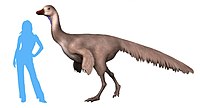 |
| Arrhinoceratops | 1925 | Horseshoe Canyon Formation (Late Cretaceous, Campanian to Maastrichtian) | ( |
Described as lacking a nasal horn although this is an artifact of preservatiom |  |
| Astrodon | 1859 | Arundel Formation (Early Cretaceous, Albian) | ( |
State dinosaur of Maryland |  |
| Astrophocaudia | 2012 | Trinity Group (Early Cretaceous, Albian) | ( |
Known from a single partial skeleton |  |
| Atlantosaurus | 1877 | Morrison Formation (Late Jurassic, Tithonian) | ( |
Potentially synonymous with Apatosaurus,[12] but a referred species may represent a separate taxon[13] | |
| Atrociraptor | 2004 | Horseshoe Canyon Formation (Late Cretaceous, Maastrichtian) | ( |
Had a short, deep snout |  |
| Aublysodon | 1868 | Judith River Formation (Late Cretaceous, Campanian) | ( |
Only known from teeth | |
| Augustynolophus | 2014 | Moreno Formation (Late Cretaceous, Maastrichtian) | ( |
State dinosaur of California. Originally named as a species of Saurolophus |  |
| Avaceratops | 1986 | Judith River Formation (Late Cretaceous, Campanian) | ( |
Lacked the fenestrae in its frill, a feature shared only with Triceratops |  |
| Bambiraptor | 2000 | Two Medicine Formation (Late Cretaceous, Campanian) | ( |
Small but well-preserved enough to display its mix of dinosaur- and bird-like features |  |
| Barosaurus | 1890 | Morrison Formation (Late Jurassic, Tithonian) | ( |
Similar to Diplodocus but larger and with a longer neck |  |
| Bistahieversor | 2010 | Fruitland Formation, Kirtland Formation (Late Cretaceous, Campanian) | ( |
Analysis of its braincase suggest it behaved like tyrannosaurids despite not being a member of that family[14] |  |
| Bisticeratops | 2022 | Kirtland Formation (Late Cretaceous, Campanian) | ( |
Originally identified as a specimen of Pentaceratops |  |
| Borealopelta | 2017 | Clearwater Formation (Early Cretaceous, Albian) | ( |
So well preserved that several osteoderms were found in the positions they would have been in when alive |  |
| Boreonykus | 2015 | Wapiti Formation (Late Cretaceous, Campanian) | ( |
One of the few dromaeosaurids known from high latitudes |  |
| Brachiosaurus | 1903 | Morrison Formation (Late Jurassic, Kimmeridgian to Tithonian) | ( |
A high browser with a tall chest and elongated forelimbs |  |
| Brachyceratops | 1914 | Two Medicine Formation (Late Cretaceous, Campanian) | ( |
Only known from juvenile remains. One specimen has been found to represent a subadult Rubeosaurus |  |
| Brachylophosaurus | 1953 | Judith River Formation, Oldman Formation (Late Cretaceous, Campanian) | ( ( |
Several specimens preserve extensive soft tissue remains |  |
| Bravoceratops | 2013 | Javelina Formation (Late Cretaceous, Campanian to Maastrichtian) | ( |
May have had a single small horn on the top of its frill |  |
| Brontomerus | 2011 | Cedar Mountain Formation (Early Cretaceous, Aptian to Albian) | ( |
Possessed an enlarged ilium which supported powerful leg muscles, which it may have used to kick away predators |  |
| Brontosaurus | 1879 | Morrison Formation (Late Jurassic, Kimmeridgian) | ( |
Popularly associated with Apatosaurus but a 2015 study found enough differences for it to be classified as a separate genus[13] |  |
| Caenagnathus | 1940 | Dinosaur Park Formation (Late Cretaceous, Campanian) | ( |
One of the largest known caenagnathids | |
| Camarasaurus | 1877 | Morrison Formation (Late Jurassic, Kimmeridgian to Tithonian) | ( |
Very common and known from multiple specimens | 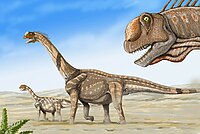 |
| Camposaurus | 1998 | Bluewater Creek Formation (Late Triassic, Norian) | ( |
Potentially the oldest known neotheropod |  |
| Camptosaurus | 1885 | Morrison Formation (Late Jurassic, Kimmeridgian to Tithonian) | ( |
May have fed on tough vegetation as evidenced by extensive wear frequently exhibited on its teeth[15] |  |
| Caseosaurus | 1998 | Tecovas Formation (Late Triassic, Norian) | ( |
Possibly synonymous with Chindesaurus | |
| Cathetosaurus | 1988 | Morrison Formation (Late Jurassic, Kimmeridgian) | ( |
A referred specimen shows possible evidence of a keratinous beak[16] | |
| Cedarosaurus | 1999 | Cedar Mountain Formation (Early Cretaceous, Valanginian) | ( |
One specimen preserves over a hundred gastroliths[17] |  |
| Cedarpelta | 2001 | Cedar Mountain Formation (Early Cretaceous, Aptian to Albian) | ( |
Lacked the extensive cranial ornamentation of later ankylosaurs | |
| Cedrorestes | 2007 | Cedar Mountain Formation (Early Cretaceous, Valanginian) | ( |
Known from a partial skeleton. The specific name, C. crichtoni, is named after Michael Crichton, author of Jurassic Park | |
| Centrosaurus | 1904 | Dinosaur Park Formation (Late Cretaceous, Campanian) | ( |
Hundreds of individuals have been preserved in a single "mega-bonebed"[18] |  |
| Cerasinops | 2007 | Two Medicine Formation (Late Cretaceous, Campanian) | ( |
Combines features of both Asian and American basal ceratopsians |  |
| Ceratops | 1888 | Judith River Formation (Late Cretaceous, Campanian) | ( |
Although only known from a few bones, this genus is the namesake of the Ceratopsia and the Ceratopsidae | |
| Ceratosaurus (C. nasicornis) (C. magnicornis) | 1884 | Morrison Formation (Late Jurassic, Kimmeridgian to Tithonian) | ( |
Possessed a row of osteoderms running down its back |  |
| Chasmosaurus | 1914 | Dinosaur Park Formation (Late Cretaceous, Campanian) | ( |
Known from multiple remains, including various skulls | 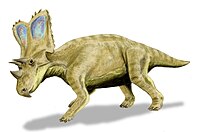 |
| Chindesaurus | 1995 | Chinle Formation (Late Triassic, Norian) | ( |
May have been a close relative of Tawa[19] | |
| Chirostenotes | 1924 | Dinosaur Park Formation (Late Cretaceous, Campanian) | ( |
Originally known only from isolated body parts |  |
| Cionodon | 1874 | Denver Formation, Judith River Formation (Late Cretaceous, Campanian to Maastrichtian) | ( ( |
Poorly known | |
| Citipes | 2020 | Dinosaur Park Formation (Late Cretaceous, Campanian) | ( |
The shape of its beak suggests a herbivorous lifestyle | |
| Claosaurus | 1890 | Niobrara Formation (Late Cretaceous, Campanian) | ( |
Historically conflated with other hadrosaurs |  |
| Coahuilaceratops | 2010 | Cerro del Pueblo Formation (Late Cretaceous, Campanian) | ( |
Possessed the longest brow horns of any ceratopsian |  |
| Coelophysis | 1889 | Chinle Formation (Late Triassic, Norian) | ( |
Known from over a thousand specimens, making it one of the more well-known early dinosaurs. Some referred species may belong to their own genera |  |
| Coelurus | 1879 | Morrison Formation (Late Jurassic, Kimmeridgian) | ( |
Potentially an early member of the tyrannosauroid lineage[20] |  |
| Colepiocephale | 2003 | Foremost Formation (Late Cretaceous, Campanian) | ( |
Originally described as a species of Stegoceras |  |
| Convolosaurus | 2019 | Twin Mountains Formation (Early Cretaceous, Aptian) | ( |
Before its formal description, it had been informally referred to as the "Proctor Lake hypsilophodont" |  |
| Coronosaurus | 2012 | Oldman Formation (Late Cretaceous, Campanian) | ( |
Had irregular masses of small spikes on the very top of its frill |  |
| Corythosaurus | 1914 | Dinosaur Park Formation, Oldman Formation (Late Cretaceous, Campanian) | ( |
Possessed a semicircular crest which may have been used for vocalization |  |
| Crittendenceratops | 2018 | Fort Crittenden Formation (Late Cretaceous, Campanian) | ( |
The youngest known member of the Nasutoceratopsini |  |
| Daemonosaurus | 2011 | Chinle Formation (Late Triassic, Rhaetian) | ( |
Unique among early theropods for possessing a short snout with long teeth |  |
| Dakotadon | 2008 | Lakota Formation (Early Cretaceous, Barremian) | ( |
Originally named as a species of Iguanodon |  |
| Dakotaraptor | 2015 | Hell Creek Formation (Late Cretaceous, Maastrichtian) | ( |
Some referred specimens may not belong to this taxon |  |
| Daspletosaurus | 1970 | Oldman Formation, Two Medicine Formation (Late Cretaceous, Campanian) | ( ( |
Instead of lips, it may have possessed crocodile-like scales on its snout[21] |  |
| Deinonychus | 1969 | Antlers Formation, Cloverly Formation (Early Cretaceous, Aptian to Albian) | ( |
Its discovery helped researchers realize that dinosaurs were active, warm-blooded animals, kicking off the Dinosaur Renaissance |  |
| Denversaurus | 1988 | Lance Formation (Late Cretaceous, Maastrichtian) | ( |
The youngest known nodosaurid[22] | |
| Diabloceratops | 2010 | Wahweap Formation (Late Cretaceous, Campanian) | ( |
Had a distinctively short and deep skull |  |
| Diclonius | 1876 | Judith River Formation (Late Cretaceous, Campanian) | ( |
Replaced its teeth in such a way that new teeth could be used at the same time as older ones | |
| Dilophosaurus | 1970 | Kayenta Formation (Early Jurassic, Sinemurian) | ( |
Possessed two semicircular crests running along the length of the skull |  |
| Dineobellator | 2020 | Ojo Alamo Formation (Late Cretaceous, Maastrichtian) | ( |
Several features of its hands and feet may be adaptations for increased grip strength[23] |  |
| Diplodocus | 1878 | Morrison Formation (Late Jurassic, Kimmeridgian) | ( |
Had a long, thin tail that may have been used like a bullwhip[24] |  |
| Diplotomodon | 1868 | Hornerstown Formation?/Navesink Formation? (Late Cretaceous, Maastrichtian) | ( |
Has been suggested to be non-dinosaurian | |
| Dromaeosaurus | 1922 | Dinosaur Park Formation (Late Cretaceous, Campanian to Maastrichtian) | ( |
Analysis of wear on its teeth suggest it preferred tougher prey, including bone |  |
| Dromiceiomimus | 1972 | Horseshoe Canyon Formation (Late Cretaceous, Maastrichtian) | ( |
May be synonymous with Ornithomimus edmontonicus |  |
| Dryosaurus | 1894 | Morrison Formation (Late Jurassic, Tithonian) | ( |
Remains of multiple growth stages have been found, including embryoes[25] |  |
| Dryptosaurus | 1877 | New Egypt Formation (Late Cretaceous, Maastrichtian) | ( |
Its discovery showed that theropods were bipedal animals |  |
| Dynamoterror | 2018 | Menefee Formation (Late Cretaceous, Campanian) | ( |
Known from only a single partial skeleton | |
| Dyoplosaurus | 1924 | Dinosaur Park Formation (Late Cretaceous, Campanian) | ( |
The holotype specimen preserves skin impressions[26] | |
| Dysganus | 1876 | Judith River Formation (Late Cretaceous, Campanian) | ( |
Four species have been named, all from isolated teeth | |
| Dyslocosaurus | 1992 | Lance Formation?/Morrison Formation? (Late Jurassic, Kimmeridgian?/Late Cretaceous, Maastrichtian?) | ( |
Has been suggested to have four claws on its hind limbs | |
| Dystrophaeus | 1877 | Morrison Formation (Late Jurassic, Kimmeridgian) | ( |
Inconsistent in phylogenetic placement, although undescribed remains could further clarify its relationships | |
| Edmontonia | 1928 | Dinosaur Park Formation (Late Cretaceous, Campanian to Maastrichtian) | ( |
Possessed forward-pointing, bifurcated spikes on its shoulders |  |
| Edmontosaurus | 1917 | Frenchman Formation, Hell Creek Formation, Horseshoe Canyon Formation, Lance Formation (Late Cretaceous, Campanian to Maastrichtian) | ( ( |
Known from multiple well-preserved specimens, including a few "mummies". Several were originally assigned to their own genera and/or species |  |
| Einiosaurus | 1994 | Two Medicine Formation (Late Cretaceous, Campanian) | ( |
Distinguished by its forward-curving nasal horn | 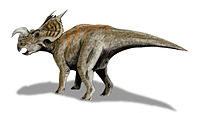 |
| Eolambia | 1998 | Cedar Mountain Formation (Late Cretaceous, Cenomanian) | ( |
Almost every single bone is known, represented by multiple fossils |  |
| Eotrachodon | 2016 | Mooreville Chalk (Late Cretaceous, Santonian) | ( |
The first Appalachian hadrosaurid known from a preserved skull[27] |  |
| Eotriceratops | 2007 | Horseshoe Canyon Formation (Late Cretaceous, Maastrichtian) | ( |
May have been the largest known ceratopsid |  |
| Epichirostenotes | 2011 | Horseshoe Canyon Formation (Late Cretaceous, Maastrichtian) | ( |
Its discovery allowed researchers to connect isolated caenagnathid body parts to each other | |
| Euoplocephalus | 1910 | Horseshoe Canyon Formation (Late Cretaceous, Maastrichtian) | ( |
Unusually, its palpebral bone was mobile, allowing it to be used as an eyelid[28] |  |
| Falcarius | 2005 | Cedar Mountain Formation (Early Cretaceous, Valanginian) | ( |
Transitional between generalized theropods and specialized therizinosaurs[29] |  |
| Ferrisaurus | 2019 | Tango Creek Formation (Late Cretaceous, Maastrichtian) | ( |
Its holotype was discovered close to a railway line[30] |  |
| Foraminacephale | 2016 | Dinosaur Park Formation, Oldman Formation (Late Cretaceous, Campanian) | ( |
Originally believed to be a species of another pachycephalosaurid genus |  |
| Fosterovenator | 2014 | Morrison Formation (Late Jurassic, Tithonian) | ( |
Has been variously described as a ceratosaurid, a tetanuran, or a close relative of Elaphrosaurus[31] |  |
| Fruitadens | 2010 | Morrison Formation (Late Jurassic, Tithonian) | ( |
One of the smallest known ornithischians[32] |  |
| Galeamopus | 2015 | Morrison Formation (Late Jurassic, Kimmeridgian) | ( |
One specimen is nearly complete, even preserving an associated skull |  |
| Gargoyleosaurus | 1998 | Morrison Formation (Late Jurassic, Kimmeridgian to Tithonian) | ( |
Combines features of both ankylosaurids and nodosaurids |  |
| Gastonia | 1998 | Cedar Mountain Formation (Early Cretaceous, Valanginian) | ( |
Several concentrations of fossils may suggest this species lived in herds[33] |  |
| Geminiraptor | 2010 | Cedar Mountain Formation (Early Cretaceous, Valanginian) | ( |
The proportions of its maxilla are similar to those of Late Cretaceous troodontids |  |
| Glishades | 2010 | Two Medicine Formation (Late Cretaceous, Campanian) | ( |
Described as a basal hadrosauroid but may in fact be a juvenile saurolophine[34] | |
| Glyptodontopelta | 2000 | Ojo Alamo Formation (Late Cretaceous, Campanian to Maastrichtian) | ( |
Originally interpreted as possessing a flat mosaic of osteoderms similar to the shields of glyptodonts | |
| Gojirasaurus | 1997 | Cooper Canyon Formation (Late Triassic, Norian) | ( |
May be a chimera consisting of undiagnostic theropod bones mixed with pseudosuchian vertebrae[35] | 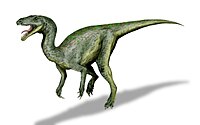 |
| Gorgosaurus | 1914 | Dinosaur Park Formation (Late Cretaceous, Campanian) | ( |
Dozens of specimens are known |  |
| Gravitholus | 1979 | Dinosaur Park Formation (Late Cretaceous, Campanian) | ( |
Potentially synonymous with Stegoceras[36] | |
| Gryphoceratops | 2012 | Milk River Formation (Late Cretaceous, Santonian) | ( |
Relatively derived despite its early age | |
| Gryposaurus | 1914 | Dinosaur Park Formation, Javelina Formation?, Kaiparowits Formation, Two Medicine Formation (Late Cretaceous, Santonian to Campanian) | ( ( |
One specimen preserves impressions of a row of pyramidal scales running along its back[37] |  |
| Hadrosaurus | 1858 | Woodbury Formation (Late Cretaceous, Campanian) | ( |
Its holotype was the first dinosaur skeleton to be mounted |  |
| Hagryphus | 2005 | Kaiparowits Formation (Late Cretaceous, Campanian) | ( |
Large but only known from a single hand |  |
| Hanssuesia | 2003 | Dinosaur Park Formation, Judith River Formation, Oldman Formation (Late Cretaceous, Campanian) | ( ( |
Possibly a synonym of Stegoceras[36] |  |
| Haplocanthosaurus | 1903 | Morrison Formation (Late Jurassic, Kimmeridgian) | ( |
May have been a basal diplodocoid[13] |  |
| Hesperonychus | 2009 | Dinosaur Park Formation (Late Cretaceous, Campanian) | ( |
A common component of its habitat as indicated by the great number of its remains |  |
| Hesperornithoides | 2019 | Morrison Formation (Late Jurassic, Kimmeridgian to Tithonian) | ( |
Before its formal description, it had been nicknamed "Lori" |  |
| Hesperosaurus | 2001 | Morrison Formation (Late Jurassic, Kimmeridgian) | ( |
Two morphotypes of plates are known, which could be explained by sexual dimorphism[38] |  |
| Hierosaurus | 1909 | Niobrara Formation (Late Cretaceous, Coniacian to Campanian) | ( |
Only known from a few bones, including osteoderms | |
| Hippodraco | 2010 | Cedar Mountain Formation (Early Cretaceous, Valanginian) | ( |
Its tooth crowns were shaped like shields |  |
| Hoplitosaurus | 1902 | Lakota Formation (Early Cretaceous, Barremian) | ( |
Known from some osteoderms, including spikes, similar to those of Polacanthus | |
| Huehuecanauhtlus | 2012 | Unnamed formation (Late Cretaceous, Santonian) | ( |
The southernmost non-hadrosaurid hadrosauroid known from North America[39] |  |
| Hypacrosaurus | 1913 | Horseshoe Canyon Formation, Two Medicine Formation (Late Cretaceous, Campanian to Maastrichtian) | ( ( |
Some juveniles of this genus were originally interpreted as dwarf lambeosaurines |  |
| Hypsibema | 1869 | Black Creek Group, Ripley Formation (Late Cretaceous, Campanian) | ( |
One of the largest known hadrosauroids | |
| Hypsirhophus | 1878 | Morrison Formation (Late Jurassic, Tithonian) | ( |
Usually seen as synonymous with Stegosaurus but may be a separate genus due to differences in its vertebrae[40] | |
| Iguanacolossus | 2010 | Cedar Mountain Formation (Early Cretaceous, Valanginian) | ( |
Large and robustly built |  |
| Invictarx | 2018 | Menefee Formation (Late Cretaceous, Campanian) | ( |
Only known from a few bones but can be distinguished from other genera by characters of its osteoderms | |
| Issi | 2021 | Fleming Fjord Formation (Late Triassic, Norian) | (Sermersooq) |
Originally described as an exemplar of Plateosaurus | |
| Jeyawati | 2010 | Moreno Hill Formation (Late Cretaceous, Turonian) | ( |
Its postorbital bone had a rugose texture |  |
| Judiceratops | 2013 | Judith River Formation (Late Cretaceous, Campanian) | ( |
Unusually, its brow horns were teardrop-shaped in cross-section |  |
| Kaatedocus | 2012 | Morrison Formation (Late Jurassic, Kimmeridgian) | ( |
One study considered it to be a basal dicraeosaurid[41] |  |
| Kayentavenator | 2010 | Kayenta Formation (Early Jurassic, Sinemurian to Pliensbachian) | ( |
Its holotype was juvenile as indicated by unfused neural spines |  |
| Koparion | 1994 | Morrison Formation (Late Jurassic, Kimmeridgian) | ( |
Known from a single tooth which may have come from a troodontid |  |
| Kosmoceratops | 2010 | Kaiparowits Formation (Late Cretaceous, Campanian) | ( |
Possessed fifteen horns and horn-like structures, including eight hornlets folding down from the top of the frill |  |
| Kritosaurus | 1910 | Kirtland Formation (Late Cretaceous, Campanian) | ( |
Has an elevated nasal bone with an enlarged nasal cavity to match |  |
| Labocania | 1974 | La Bocana Roja Formation (Late Cretaceous, Campanian) | ( |
Robustly built with particularly strengthened frontals |  |
| Lambeosaurus | 1923 | Dinosaur Park Formation (Late Cretaceous, Campanian) | ( |
Possessed a hollow head crest that varied in shape between species, sexes, and ages. Most familiarly, it was hatchet-shaped in adult male L. lambei |  |
| Laosaurus | 1878 | Morrison Formation (Late Jurassic, Kimmeridgian to Tithonian) | ( |
Several referred specimens have been reassigned to other taxa | |
| Latenivenatrix | 2017 | Dinosaur Park Formation (Late Cretaceous, Campanian) | ( |
The largest known troodontid |  |
| Latirhinus | 2012 | Cerro del Pueblo Formation (Late Cretaceous, Campanian) | ( |
Potentially a chimera composed of lambeosaurine and saurolophine remains[42] | |
| Lepidus | 2015 | Dockum Group (Late Triassic, Norian) | ( |
Muscle scars are preserved on the holotype bones |  |
| Leptoceratops | 1914 | Hell Creek Formation, Lance Formation, Scollard Formation (Late Cretaceous, Maastrichtian) | ( ( |
Analysis of its teeth show it could chew like a mammal, an adaptation to eating tough, fibrous plants[43] |  |
| Leptorhynchos | 2013 | Aguja Formation (Late Cretaceous, Campanian to Maastrichtian) | ( |
Had a slightly upturned mandible similar to those of oviraptorids |  |
| Lophorhothon | 1960 | Mooreville Chalk Formation (Late Cretaceous, Campanian) | ( |
Although incomplete, the holotype skull preserves evidence of a crest | |
| Lythronax | 2013 | Wahweap Formation (Late Cretaceous, Campanian) | ( |
Already had the forward-directed orbits of derived tyrannosaurids despite its early age |  |
| Machairoceratops | 2016 | Wahweap Formation (Late Cretaceous, Campanian) | ( |
Possessed two long, forward-pointing horns on the top of its frill |  |
| Magnapaulia | 2012 | El Gallo Formation (Late Cretaceous, Campanian) | ( |
Has been suggested to be semi-aquatic due to its tall, narrow tail[44] |  |
| Maiasaura | 1979 | Oldman Formation, Two Medicine Formation (Late Cretaceous, Campanian) | ( ( |
Remains of hundreds of individuals, including juveniles, eggs, and nests, have been found at a single site[45] |  |
| Maraapunisaurus | 2018 | Morrison Formation (Late Jurassic, Tithonian) | ( |
Named from a single, lost vertebra of immense size | |
| Marshosaurus | 1976 | Morrison Formation (Late Jurassic, Kimmeridgian) | ( |
Potentially a close relative of South America megalosauroids[46] |  |
| Martharaptor | 2012 | Cedar Mountain Formation (Early Cretaceous, Valanginian) | ( |
Had not yet acquired the robust feet of derived therizinosaurs |  |
| Medusaceratops | 2010 | Judith River Formation (Late Cretaceous, Campanian) | ( |
Possessed elongated spikes curving away from the sides of its frill |  |
| Menefeeceratops | 2021 | Menefee Formation (Late Cretaceous, Campanian) | ( |
One of the oldest centrosaurines | |
| Mercuriceratops | 2014 | Dinosaur Park Formation, Judith River Formation (Late Cretaceous, Campanian) | ( ( |
Had a "wing"-like projection on its squamosal bone |  |
| Microvenator | 1970 | Cloverly Formation (Early Cretaceous, Albian) | ( |
Teeth from Deinonychus have been mistakenly attributed to this species | 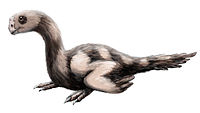 |
| Mierasaurus | 2017 | Cedar Mountain Formation (Early Cretaceous, Valanginian) | ( |
One of the latest-surviving turiasaurs[47] | |
| Moabosaurus | 2017 | Cedar Mountain Formation (Early Cretaceous, Aptian) | ( |
Described as a macronarian[48] but has since been reinterpreted as a turiasaur closely related to Mierasaurus[47] |  |
| Monoclonius | 1876 | Dinosaur Park Formation, Judith River Formation (Late Cretaceous, Campanian) | ( ( |
Only known from indistinct remains of juveniles and subadults |  |
| Montanoceratops | 1951 | Horseshoe Canyon Formation, St. Mary River Formation (Late Cretaceous, Maastrichtian) | ( ( |
Often restored with a short nasal horn although this may be a displaced cheek horn[49] |  |
| Moros | 2019 | Cedar Mountain Formation (Late Cretaceous, Cenomanian) | ( |
The proportions of its metatarsals are similar to those of ornithomimids |  |
| Mymoorapelta | 1994 | Morrison Formation (Late Jurassic, Kimmeridgian to Tithonian) | ( |
The first ankylosaur described from the Morrison Formation | |
| Naashoibitosaurus | 1993 | Kirtland Formation (Late Cretaceous, Campanian) | ( |
Had a nasal arch that was not as tall as that of Gryposaurus | |
| Nanosaurus | 1877 | Morrison Formation (Late Jurassic, Kimmeridgian to Tithonian) | ( |
Several referred specimens were originally assigned to other genera |  |
| Nanuqsaurus | 2014 | Prince Creek Formation (Late Cretaceous, Maastrichtian) | ( |
Described as a dwarf tyrannosaurid although undescribed remains suggest a size comparable to Albertosaurus[50] |  |
| Nasutoceratops | 2013 | Kaiparowits Formation (Late Cretaceous, Campanian) | ( |
Possessed an enlarged nasal cavity and two long, curving horns similar to those of modern cattle |  |
| Navajoceratops | 2020 | Kirtland Formation (Late Cretaceous, Campanian) | ( |
Had a distinctive notch at the very top of its frill, similar to its potential ancestor Pentaceratops | |
| Nedcolbertia | 1998 | Cedar Mountain Formation (Early Cretaceous, Valanginian) | ( |
Known from three partial skeletons. The specific name, N. justinhofmanni, honors a six-year-old schoolboy who won a contest to have a dinosaur named after him |  |
| Nevadadromeus | 2022 | Willow Tank Formation (Late Cretaceous, Coniacian) | ( |
||
| Niobrarasaurus | 1995 | Niobrara Formation (Late Cretaceous, Coniacian to Campanian) | ( |
Originally mistakenly believed to have been aquatic[52] | |
| Nodocephalosaurus | 1999 | Kirtland Formation (Late Cretaceous, Campanian to Maastrichtian) | ( |
Closely related to Asian ankylosaurs[53] | |
| Nodosaurus | 1889 | Frontier Formation (Late Cretaceous, Cenomanian to Coniacian) | ( |
Its armor included banded dermal plates interspersed by bony nodules |  |
| Nothronychus | 2001 | Moreno Hill Formation, Tropic Shale (Late Cretaceous, Turonian) | ( |
Would have lived in the marshes and swamps[54] along the Turonian shoreline[55] |  |
| Ojoraptorsaurus | 2011 | Ojo Alamo Formation (Late Cretaceous, Maastrichtian) | ( |
Only known from an incomplete pair of pubes |  |
| Oohkotokia | 2013 | Two Medicine Formation (Late Cretaceous, Campanian to Maastrichtian) | ( |
Potentially a synonym of Scolosaurus[56] | |
| Ornatops | 2021 | Menefee Formation (Late Cretaceous, Campanian) | ( |
Preserves a pair of bumps on its skull which may have anchored a crest | |
| Ornitholestes | 1903 | Morrison Formation (Late Jurassic, Kimmeridgian) | ( |
May have possessed a sickle claw similar to those of dromaeosaurids[57] |  |
| Ornithomimus | 1890 | Denver Formation, Dinosaur Park Formation, Horseshoe Canyon Formation (Late Cretaceous, Campanian to Maastrichtian) | ( ( |
One referred specimen preserves impressions of ostrich-like feathers covering most of its body[58] |  |
| Orodromeus | 1988 | Two Medicine Formation (Late Cretaceous, Campanian) | ( |
Eggs considered to belong to this taxon may have actually come from a troodontid[59] |  |
| Oryctodromeus | 2007 | Blackleaf Formation, Wayan Formation (Late Cretaceous, Cenomanian) | ( |
Several specimens have been preserved in burrows | 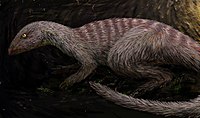 |
| Osmakasaurus | 2011 | Lakota Formation (Early Cretaceous, Valanginian) | ( |
Originally named as a species of Camptosaurus | |
| Pachycephalosaurus | 1943 | Hell Creek Formation, Lance Formation (Late Cretaceous, Maastrichtian) | ( |
Possessed a tall, rounded head dome surrounded by bony knobs |  |
| Pachyrhinosaurus | 1950 | Horseshoe Canyon Formation, Prince Creek Formation, St. Mary River Formation (Late Cretaceous, Campanian to Maastrichtian) | ( ( |
Three species have been named, each with a unique pattern of cranial ornamentation |  |
| Panoplosaurus | 1919 | Dinosaur Park Formation (Late Cretaceous, Campanian) | ( |
Unlike other nodosaurs, it lacked enlarged spikes |  |
| Parasaurolophus | 1922 | Dinosaur Park Formation, Fruitland Formation, Kaiparowits Formation, Kirtland Formation (Late Cretaceous, Campanian) | ( ( |
Possessed a curved, hollow crest that varied in size between species |  |
| Paraxenisaurus | 2020 | Cerro del Pueblo Formation (Late Cretaceous, Campanian) | ( |
Described as the first deinocheirid from North America |  |
| Parksosaurus | 1937 | Horseshoe Canyon Formation (Late Cretaceous, Maastrichtian) | ( |
Had long toes which may be an adaptation to walking on soft soils in watercourses and marshlands[54] |  |
| Paronychodon | 1876 | Hell Creek Formation, Judith River Formation, Lance Formation (Late Cretaceous, Campanian to Maastrichtian) | ( |
Only known from highly distinctive teeth | |
| Pawpawsaurus | 1996 | Paw Paw Formation (Early Cretaceous, Albian) | ( |
Had enlarged nasal cavities that gave it an acute sense of smell, even more powerful than that of contemporary theropods[60] | |
| Pectinodon | 1982 | Hell Creek Formation, Lance Formation (Late Cretaceous, Maastrichtian) | ( |
Had comb-like serrations on its teeth | |
| Peloroplites | 2008 | Cedar Mountain Formation (Late Cretaceous, Cenomanian to Turonian) | ( |
One of the largest known nodosaurids | |
| Pentaceratops | 1923 | Fruitland Formation, Kirtland Formation (Late Cretaceous, Campanian) | ( |
Its epijugal bones (the hornlets under its eyes) were relatively large |  |
| Planicoxa | 2001 | Cedar Mountain Formation (Early Cretaceous, Barremian to Albian) | ( |
The rear of its ilium was characteristically flat | |
| Platypelta | 2018 | Dinosaur Park Formation (Late Cretaceous, Campanian) | ( |
Originally assigned to Euoplocephalus but given its own genus because of several morphological differences | |
| Podokesaurus | 1911 | Portland Formation (Early Jurassic, Hettangian to Sinemurian) | ( |
May have had a tail one and a half times longer than the rest of its skeleton[61] |  |
| Polyodontosaurus | 1932 | Dinosaur Park Formation (Late Cretaceous, Campanian) | ( |
May be identical to Latenivenatrix[62] | |
| Polyonax | 1874 | Denver Formation (Late Cretaceous, Maastrichtian) | ( |
Poorly known | |
| Prenoceratops | 2004 | Two Medicine Formation (Late Cretaceous, Campanian) | ( |
The only basal ceratopsian known from a bonebed |  |
| Priconodon | 1888 | Arundel Formation (Early Cretaceous, Aptian to Albian) | ( |
Large but only known from teeth | |
| Probrachylophosaurus | 2015 | Foremost Formation, Judith River Formation (Late Cretaceous, Campanian) | ( ( |
Shows a skull morphology transitional between crestless and crested brachylophosaurins |  |
| Propanoplosaurus | 2011 | Patuxent Formation (Early Cretaceous, Aptian) | ( |
Only known from the imprints of a neonate skeleton |  |
| Prosaurolophus | 1916 | Dinosaur Park Formation, Two Medicine Formation (Late Cretaceous, Campanian) | ( ( |
Had a relatively large head for a hadrosaur | 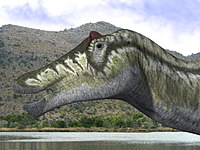 |
| Protohadros | 1998 | Woodbine Formation (Late Cretaceous, Cenomanian) | ( |
Possessed a downturned jaw which may be an adaptation to grazing on low-growing plants | |
| Pteropelyx | 1889 | Judith River Formation (Late Cretaceous, Campanian) | ( |
Potentially synonymous with Corythosaurus, although this cannot be confirmed due to a lack of cranial remains[63] | |
| Rativates | 2016 | Dinosaur Park Formation (Late Cretaceous, Campanian) | ( |
Originally described as a specimen of Struthiomimus |  |
| Regaliceratops | 2015 | St. Mary River Formation (Late Cretaceous, Maastrichtian) | ( |
Possessed a series of large, pentagonal plates lining its frill |  |
| Richardoestesia | 1990 | Aguja Formation, Dinosaur Park Formation (Late Cretaceous, Campanian) | ( ( |
Teeth assigned to this genus have been recovered all around the world, although they may not represent a single taxon | |
| Rugocaudia | 2012 | Cloverly Formation (Early Cretaceous, Aptian to Albian) | ( |
Some of this genus' remains include several caudal vertebrae |  |
| Sarahsaurus | 2011 | Kayenta Formation (Early Cretaceous, Sinemurian to Pliensbachian) | ( |
Possessed strong hands which may indicate a feeding specialization |  |
| Saurolophus | 1912 | Horseshoe Canyon Formation (Late Cretaceous, Maastrichtian) | ( |
Had a short, solid crest that pointed directly upwards. A larger, more well-known species has been found in Mongolia |  |
| Sauropelta | 1970 | Cloverly Formation (Early Cretaceous, Albian) | ( |
Its tail had at least forty vertebrae, making up half of its total body length | 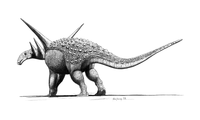 |
| Sauroposeidon | 2000 | Antlers Formation, Glen Rose Formation (Early Cretaceous, Aptian to Albian) | ( |
Could raise its head up to 18 metres (59 ft) in the air, the height of a six-storey building[64] |  |
| Saurornitholestes | 1978 | Coachman Formation, Dinosaur Park Formation, Donoho Creek Formation, Kirtland Formation, Mooreville Chalk, Oldman Formation, Tar Heel Formation, Two Medicine Formation (Late Cretaceous, Campanian) | ( ( ( |
Its second premaxillary teeth could be adapted to preening feathers[65] |  |
| Scolosaurus | 1928 | Dinosaur Park Formation, Oldman Formation (Late Cretaceous, Campanian) | ( |
Once widely believed to be synonymous with other Dinosaur Park ankylosaurids |  |
| Scutellosaurus | 1981 | Kayenta Formation (Early Jurassic, Sinemurian) | ( |
Had hundreds of osteoderms arranged in rows along its back and tail |  |
| Segisaurus | 1936 | Navajo Sandstone (Early Jurassic, Pliensbachian to Toarcian) | ( |
Preserves evidence of a wishbone similar to that of modern birds | 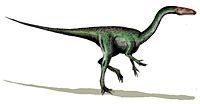 |
| Seitaad | 2010 | Navajo Sandstone (Early Jurassic, Pliensbachian) | ( |
The holotype may have died when a sand dune collapsed on it[66] |  |
| Siats | 2013 | Cedar Mountain Formation (Late Cretaceous, Cenomanian) | ( |
Large but inconsistent in phylogenetic placement |  |
| Sierraceratops | 2022 | Hall Lake Formation (Late Cretaceous, Campanian to Maastrichtian) | ( |
May be part of a unique clade of ceratopsians only known from southern Laramidia[67] | |
| Silvisaurus | 1960 | Dakota Formation (Early Cretaceous to Late Cretaceous, Albian to Cenomanian) | ( |
Hypothesized to live in a forested habitat |  |
| Smitanosaurus | 2020 | Morrison Formation (Late Jurassic, Kimmeridgian to Tithonian) | ( |
Only known from a partial skull and some vertebrae | |
| Sonorasaurus | 1998 | Turney Ranch Formation (Early Cretaceous to Late Cretaceous, Albian to Cenomanian) | ( |
State dinosaur of Arizona |  |
| Sphaerotholus | 2002 | Frenchman Formation, Hell Creek Formation, Horseshoe Canyon Formation, Kirtland Formation (Late Cretaceous, Campanian to Maastrichtian) | ( ( |
Although only known from skull fragments, this genus lived in a broad range |  |
| Spiclypeus | 2016 | Judith River Formation (Late Cretaceous, Campanian) | ( |
Has been described as "boldly audacious". Possibly identical to Ceratops[68] |  |
| Spinops | 2011 | Dinosaur Park Formation?/Oldman Formation? (Late Cretaceous, Campanian) | ( |
Described almost a century after its remains were collected |  |
| Stegoceras | 1902 | Dinosaur Park Formation, Fruitland Formation, Kirtland Formation, Oldman Formation (Late Cretaceous, Campanian) | ( ( |
May have been an indiscriminate bulk-feeder due to the shape of its snout[69] |  |
| Stegopelta | 1905 | Frontier Formation (Early Cretaceous to Late Cretaceous, Albian to Cenomanian) | ( |
May have possessed a sacral shield similar to other nodosaurs | |
| Stegosaurus | 1877 | Morrison Formation (Late Jurassic, Kimmeridgian to Tithonian) | ( |
Had a single alternating row of large, kite-shaped plates |  |
| Stellasaurus | 2020 | Two Medicine Formation (Late Cretaceous, Campanian) | ( |
Possessed an enlarged, thickened nasal horn |  |
| Stenonychosaurus | 1932 | Dinosaur Park Formation (Late Cretaceous, Campanian) | ( |
Compared to its body mass, its brain was one of the largest of any non-avian dinosaur's |  |
| Stephanosaurus | 1914 | Dinosaur Park Formation (Late Cretaceous, Campanian) | ( |
Poorly known | |
| Stokesosaurus | 1974 | Morrison Formation (Late Jurassic, Tithonian) | ( |
Only known from a few remains but they are enough to tell that it was a tyrannosauroid |  |
| Struthiomimus | 1917 | Oldman Formation (Late Cretaceous, Campanian) | ( |
Known from many specimens, indicating it was a common animal |  |
| Styracosaurus | 1913 | Dinosaur Park Formation, Two Medicine Formation? (Late Cretaceous, Campanian) | ( ( |
Possessed several long horns jutting out from the top of its frill, the patterns of which could have varied between individuals[70] |  |
| Supersaurus | 1985 | Morrison Formation (Late Jurassic, Tithonian) | ( |
Several remains were originally believed to represent their own genera |  |
| Suskityrannus | 2019 | Moreno Hill Formation (Late Cretaceous, Turonian) | ( |
Small yet already possessed several features of large, derived tyrannosaurids, including an arctometatarsus |  |
| Suuwassea | 2004 | Morrison Formation (Late Jurassic, Kimmeridgian to Tithonian) | ( |
Shares features with both diplodocids and dicraeosaurids, but is more likely a member of the latter group[13][41] | |
| Talos | 2011 | Kaiparowits Formation (Late Cretaceous, Campanian) | ( |
The holotype specimen preserves a pathology on its sickle claw[71] |  |
| Tanycolagreus | 2005 | Morrison Formation (Late Jurassic, Kimmeridgian to Tithonian) | ( |
Had a long, blunt snout |  |
| Tatankacephalus | 2009 | Cloverly Formation (Early Cretaceous, Aptian to Albian) | ( |
Retained premaxillary teeth in its upper jaws, a basal trait | |
| Tawa | 2009 | Chinle Formation (Late Triassic, Norian) | ( |
Well-preserved but inconsistent in phylogenetic placement |  |
| Tenontosaurus | 1970 | Antlers Formation, Arundel Formation, Cedar Mountain Formation, Cloverly Formation, Paluxy Formation, Twin Mountains Formation, Wayan Formation (Early Cretaceous, Aptian to Albian) | ( |
Remains of this genus are often found associated with skeletons of Deinonychus[72] |  |
| Teratophoneus | 2011 | Kaiparowits Formation (Late Cretaceous, Campanian) | ( |
Its snout was shorter and deeper than those of other tyrannosaurids |  |
| Terminocavus | 2020 | Kirtland Formation (Late Cretaceous, Campanian) | ( |
Had a teardrop-shaped hole on the top of its frill which was almost closed off by a pair of epoccipitals |  |
| Texacephale | 2010 | Aguja Formation (Late Cretaceous, Campanian) | ( |
Possessed a series of vertical flanges on its dome which may have functioned as "gears" that interlocked when head-butting | |
| Texasetes | 1995 | Paw Paw Formation (Early Cretaceous, Albian) | ( |
Potentially synonymous with Pawpawsaurus | |
| Thanatotheristes | 2020 | Foremost Formation (Late Cretaceous, Campanian) | ( |
May be a species of Daspletosaurus[73] |  |
| Theiophytalia | 2006 | Purgatoire Formation (Early Cretaceous, Aptian to Albian) | ( |
Only known from a skull originally referred to Camptosaurus | |
| Thescelosaurus | 1913 | Frenchman Formation, Hell Creek Formation, Lance Formation, Laramie Formation, Scollard Formation (Late Cretaceous, Maastrichtian) | ( ( |
One specimen was originally considered to have preserved its heart, although later this was found to be a mineral concretion[74] |  |
| Thespesius | 1856 | Lance Formation (Late Cretaceous, Maastrichtian) | ( |
Once suggested to be a possible Miocene mammal | |
| Tichosteus | 1877 | Morrison Formation (Late Jurassic, Kimmeridgian) | ( |
Two species have been named, both from isolated vertebrae | |
| Titanoceratops | 2011 | Fruitland Formation?/Kirtland Formation? (Late Cretaceous, Campanian) | ( |
Potentially a large, old specimen of Pentaceratops | 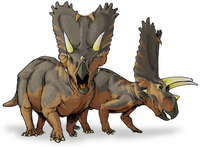 |
| Tlatolophus | 2021 | Cerro del Pueblo Formation (Late Cretaceous, Campanian) | ( |
Possessed a short, broad crest resembling an inverted comma |  |
| Torosaurus | 1891 | Hell Creek Formation, Lance Formation (Late Cretaceous, Maastrichtian) | ( |
Once believed to be potentially synonymous with Triceratops |  |
| Torvosaurus | 1979 | Morrison Formation (Late Jurassic, Tithonian) | ( |
Had short but powerfully built arms. Several species, many of them unnamed, have been found in Europe, South America, and possibly Africa |  |
| Tototlmimus | 2016 | Packard Formation (Late Cretaceous, Campanian) | ( |
The southernmost ornithomimid known from North America | |
| Trachodon | 1856 | Judith River Formation (Late Cretaceous, Campanian) | ( |
Several remains assigned to this genus actually belong to other taxa, most notably Edmontosaurus | |
| Triceratops | 1889 | Denver Formation, Evanston Formation, Hell Creek Formation, Lance Formation, Laramie Formation, Scollard Formation (Late Cretaceous, Maastrichtian) | ( ( |
A common ceratopsid with long brow horns and a short nasal horn |  |
| Trierarchuncus | 2020 | Hell Creek Formation (Late Cretaceous, Maastrichtian) | ( |
Known from remains of different sizes which depict how the claws of alvarezsaurids grew more hooked as they aged | |
| Troodon | 1856 | Judith River Formation (Late Cretaceous, Campanian) | ( |
Only known from teeth. Most referred skeletal remains cannot be confidently assigned to this genus[62] |  |
| Tyrannosaurus | 1905 | Frenchman Formation, Hell Creek Formation, Lance Formation, Willow Creek Formation (Late Cretaceous, Maastrichtian) | ( ( |
The last, largest, and most well-known tyrannosaurid |  |
| Unescoceratops | 2012 | Dinosaur Park Formation (Late Cretaceous, Campanian) | ( |
Had the roundest teeth of any known leptoceratopsid | |
| Utahceratops | 2010 | Kaiparowits Formation (Late Cretaceous, Campanian) | ( |
Almost the entire skeleton and skull is known |  |
| Utahraptor | 1993 | Cedar Mountain Formation (Early Cretaceous, Berriasian to Valanginian) | ( |
Very large and powerfully built |  |
| Uteodon | 2011 | Morrison Formation (Late Jurassic, Tithonian) | ( |
May be a species of Camptosaurus, with a referred braincase being from Dryosaurus[75] | |
| Vagaceratops | 2010 | Dinosaur Park Formation (Late Cretaceous, Campanian) | ( |
Possessed a row of fused epoccipitals folding over the top of the frill |  |
| Velafrons | 2007 | Cerro del Pueblo Formation (Late Cretaceous, Campanian) | ( |
May have had elongated neural spines similar to those of Hypacrosaurus altispinus |  |
| Venenosaurus | 2001 | Cedar Mountain Formation (Early Cretaceous, Aptian to Albian) | ( |
Its skeleton has traits of both titanosaurs and more basal macronarians | |
| Wendiceratops | 2015 | Oldman Formation (Late Cretaceous, Campanian) | ( |
Had three pairs of enlarged, curved epiparietals at the very top of its frill |  |
| Xenoceratops | 2012 | Foremost Formation (Late Cretaceous, Campanian) | ( |
Possessed two long spines at the top of its frill with smaller knobs at their bases |  |
| Yehuecauhceratops | 2017 | Aguja Formation (Late Cretaceous, Campanian) | ( |
One of the smallest known ceratopsids |  |
| Yurgovuchia | 2012 | Cedar Mountain Formation (Early Cretaceous, Valanginian) | ( |
May have had a flexible tail due to the structure of its caudal vertebrae |  |
| Zapsalis | 1876 | Judith River Formation (Late Cretaceous, Campanian) | ( |
Some teeth referred to this genus actually belong to Saurornitholestes[65] | |
| Zephyrosaurus | 1980 | Cloverly Formation (Early Cretaceous, Aptian to Albian) | ( |
Currently only known from fragmentary remains but several undescribed specimens exist[76] | |
| Ziapelta | 2014 | Kirtland Formation (Late Cretaceous, Campanian) | ( |
Many specimens are known, most from the front part of the animal |  |
| Zuniceratops | 1998 | Moreno Hill Formation (Late Cretaceous, Turonian) | ( |
Carried a pair of brow horns despite not being a member of the Ceratopsidae |  |
| Zuul | 2017 | Judith River Formation (Late Cretaceous, Campanian) | ( |
Several osteoderms, keratin, and skin remains were found in the positions they had in life |  |
Dubious, uncertain, and invalid genera
- Agathaumas sylvestris: Most well known from a painting by Charles Knight. It may have been a synonym of Triceratops, but without cranial remains, this cannot be confirmed.
- Antrodemus valens: May represent the same animal as Allosaurus; if so, the name Antrodemus would have priority. However, because it is based on undiagnostic remains of uncertain provenance, this cannot be confirmed.
- Apatodon mirus: Its holotype was originally believed to be the jawbone of a Mesozoic pig, but has been reinterpreted as a dinosaur vertebra. What type of dinosaur it belonged to is unknown, but there have been suggestions that it was from Allosaurus.
- "Beelemodon": Known only from two teeth found in Wyoming. They share features of compsognathids, dromaeosaurids, and basal oviraptorosaurs.
- "Capitalsaurus": The official dinosaur of the District of Columbia. It is known from a single vertebra discovered at the intersection of First and F Streets S.E., which is now appropriately named "Capitalsaurus Court".
- Claorhynchus trihedrus: An indeterminate cerapod that may be either a hadrosaurid or a ceratopsid, in which case it may be a synonym of Triceratops.
- "Coelosaurus" antiquus: The generic name is said to be preoccupied, but its namesake remains obscure.
- "Comanchesaurus kuesi": Only named in a dissertation. It has been described as a possible indeterminate saurischian.
- Deinodon horridus: Only known from teeth. Several referred teeth have since been found to belong to already known species, and the holotype could itself belong to Gorgosaurus.
- Dracorex hogwartsia: Described as a small, flat-headed pachycephalosaur. However, it is likely that it is just a juvenile Pachycephalosaurus.
- Drinker nisti: May be a synonym of Nanosaurus.
- Epanterias amplexus: Possibly a large specimen of Allosaurus, but it may be a different taxon due to its younger age.
- "Magulodon muirkirkensis": Only known from a single tooth that may belong to either an ornithopod or a basal ceratopsian.
- "Microcephale": Said to be an extremely small pachycephalosaur, with skull caps only 5 centimetres (2.0 in) long.
- Mojoceratops perifania: May be a species of specimen of Chasmosaurus.
- Nanotyrannus lancensis: Described as a small adult tyrannosaur, although it is more likely to be a juvenile Tyrannosaurus rex.
- Nedoceratops hatcheri: Due to its lack of a nasal horn, it has been named "Diceratops" (which is preoccupied by an insect) and Diceratus. However, it may simply be an unusual specimen of Triceratops.
- Ojoceratops fowleri: May be ancestral to Triceratops or a synonym of Eotriceratops.
- "Orcomimus": Potentially referrable to any of the ornithomimosaur taxa known from the Hell Creek Formation.
- Othnielia rex: Only known from an undiagnostic femur, but it may have belonged to Nanosaurus anyway.
- Othnielosaurus consors: Most likely a synonym of Nanosaurus.
- Palaeopteryx thomsoni: Known from a few very small bones which could belong to either a bird or a small bird-like dinosaur.
- Paleoscincus costatus: Most likely a nodosaurid.
- Protoavis texensis: Described as a Triassic bird but is more likely a chimera consisting of elements from various unrelated tetrapods.
- Rhinorex condrupus: Phylogenetic analysis shows that it may fall within Gryposaurus, and thus be a junior synonym of that genus.
- Rubeosaurus ovatus: Likely a species of Styracosaurus, or even simply an unusual specimen of S. albertensis.
- Saurophaganax maximus: Potentially an extremely large specimen of Allosaurus.
- Stygimoloch spinifer: Had a short skull dome with long horns jutting out from behind it. It is usually thought to be a subadult Pachycephalosaurus, but has been noted to be stratigraphically younger.
- Tatankaceratops sacrisonorum: Noted to possess a strange mix of features of both juvenile and adult Triceratops. It may be a dwarf specimen of that genus or an individual that stopped growing prematurely.
Timeline
This is a timeline of selected dinosaurs from the list above. Time is measured in Ma, megaannum, along the x-axis.

See also
- List of North American birds
References
- HUBER, P. (1998). The oldest Late Triassic footprint assemblage from North America (Pekin Formation, Deep River Basin, North Carolina, USA). Southeastern Geology, 38(2), 77-90.
- Sarıgül, Volkan (2018-11-17). "New archosauromorph fragments from the Dockum Group of Texas and assessment of the earliest dinosaurs in North America". Historical Biology. 30 (8): 1059–1075. doi:10.1080/08912963.2017.1333609. ISSN 0891-2963. S2CID 134371261.
- Horne, Gregory S. (1994-03-31). "A mid-Cretaceous ornithopod from central Honduras". Journal of Vertebrate Paleontology. 14 (1): 147–150. doi:10.1080/02724634.1994.10011548. ISSN 0272-4634.
- "HONDURAS AND THE DINOSAURS - Escuela de Biología". biologia.unah.edu.hn (in Spanish). Retrieved 2022-07-29.
- Longrich, Nicholas R.; Suberbiola, Xabier Pereda; Pyron, R. Alexander; Jalil, Nour-Eddine (2021). "The first duckbill dinosaur (Hadrosauridae: Lambeosaurinae) from Africa and the role of oceanic dispersal in dinosaur biogeography". Cretaceous Research. 120: 104678. doi:10.1016/j.cretres.2020.104678. S2CID 228807024.
- Fowler, D. W.; Sullivan, R. M. (2011). "The First Giant Titanosaurian Sauropod from the Upper Cretaceous of North America". Acta Palaeontologica Polonica. 56 (4): 685. CiteSeerX 10.1.1.694.3759. doi:10.4202/app.2010.0105. S2CID 53126360.
- Eberth, David A.; Currie, Philip J. (2010). "Stratigraphy, sedimentology, and taphonomy of the Albertosaurus bonebed (upper Horseshoe Canyon Formation; Maastrichtian), southern Alberta, Canada". Canadian Journal of Earth Sciences. 47 (9): 1119–1143. Bibcode:2010CaJES..47.1119E. doi:10.1139/e10-045.
- Costa, Francisco; Mateus, Octávio; Joger, Ulrich (13 November 2019). "Dacentrurine stegosaurs (Dinosauria): A new specimen of Miragaia longicollum from the Late Jurassic of Portugal resolves taxonomical validity and shows the occurrence of the clade in North America". PLOS ONE. 14 (11): e0224263. Bibcode:2019PLoSO..1424263C. doi:10.1371/journal.pone.0224263. PMC 6853308. PMID 31721771.
- Prieto-Márquez, A. 2014. "Skeletal morphology of Kritosaurus navajovius (Dinosauria:Hadrosauridae) from the Late Cretaceous of the North American south-west, with an evaluation of the phylogenetic systematics and biogeography of Kritosaurini". Journal of Systematic Palaeontology 12(2): 133-175
- Smith, Nathan (1820). "Fossil bones found in red sandstones". American Journal of Science. 2: 146–147.
- Wagner, Jonathan R. (2001). The hadrosaurian dinosaurs (Ornithischia: Hadrosauria) of Big Bend National Park, Brewster County, Texas, with implications for Late Cretaceous paleozoogeography (MSc).
- Taylor, M.P. (2010). "Sauropod dinosaur research: a historical review." Pp. 361-386 in Moody, R.T.J., Buffetaut, E., Naish, D. and Martill, D.E. (eds.), Dinosaurs and Other Extinct Saurians: A Historical Perspective. London: The Geological Society, Special Publication No. 34.
- Tschopp, E.; Mateus, O. V.; Benson, R. B. J. (2015). "A specimen-level phylogenetic analysis and taxonomic revision of Diplodocidae (Dinosauria, Sauropoda)". PeerJ. 3: e857. doi:10.7717/peerj.857. PMC 4393826. PMID 25870766.
- McKeown, Matthew; Brusatte, Stephen L.; Williamson, Thomas E.; Schwab, Julia A.; Carr, Thomas D.; Butler, Ian B.; Muir, Amy; Schroeder, Katlin; Espy, Michelle A.; Hunter, James F.; Losko, Adrian S. (2020). "Neurosensory and Sinus Evolution as Tyrannosauroid Dinosaurs Developed Giant Size: Insight from the Endocranial Anatomy of Bistahieversor sealeyi" (PDF). The Anatomical Record. 303 (4): 1043–1059. doi:10.1002/ar.24374. hdl:20.500.11820/8c657729-91df-4f7c-bca5-b9c469781768. ISSN 1932-8494. PMID 31967416. S2CID 210871038.
- Foster, J. (2007). "Camptosaurus dispar." Jurassic West: The Dinosaurs of the Morrison Formation and Their World. Indiana University Press. p. 219-221.
- Wiersma, K.; Sander, P. M. (2016). "The dentition of a well-preserved specimen of Camarasaurus sp.: implications for function, tooth replacement, soft part reconstruction, and food intake". PalZ. 91: 145–161. doi:10.1007/s12542-016-0332-6. S2CID 89088005.
- Sanders, F.; Manley, K.; Carpenter, K. (2001). "Gastroliths from the Lower Cretaceous sauropod Cedarosaurus weiskopfae". In Tanke, Darren; Carpenter, Ken (eds.). Mesozoic Vertebrate Life: New Research Inspired by the Paleontology of Philip J. Currie. Indiana University Press. pp. 166–180. ISBN 0-253-33907-3.
- D.A. Eberth, D.B. Brinkman, V. Barkas, "A centrosaurine mega-bonebed from the Upper Cretaceous of southern Alberta: Implications for behaviour and death events" in New Perspectives on Horned Dinosaurs: The Ceratopsian Symposium at the Royal Tyrrell Museum, September 2007 (2010).
- Novas, Fernando E.; Agnolin, Federico L.; Ezcurra, Martín D.; Temp Müller, Rodrigo; Martinelli, Agustín G.; Langer, Max C. (October 2021). "Review of the fossil record of early dinosaurs from South America, and its phylogenetic implications". Journal of South American Earth Sciences. 110: 103341. Bibcode:2021JSAES.11003341N. doi:10.1016/j.jsames.2021.103341.
- Cau, Andrea; Brougham, Tom; Naish, Darren (2015). "The phylogenetic affinities of the bizarre Late Cretaceous Romanian theropod Balaur bondoc (Dinosauria, Maniraptora): Dromaeosaurid or flightless bird?". PeerJ. 3: e1032. doi:10.7717/peerj.1032. PMC 4476167. PMID 26157616.
- Carr, Thomas D.; Varricchio, David J.; Sedlmayr, Jayc C.; Roberts, Eric M.; Moore, Jason R. (2017). "A new tyrannosaur with evidence for anagenesis and crocodile-like facial sensory system". Scientific Reports. 7: 44942. Bibcode:2017NatSR...744942C. doi:10.1038/srep44942. PMC 5372470. PMID 28358353.
- Bakker, R.T. (1988). "Review of the Late Cretaceous nodosauroid Dinosauria: Denversaurus schlessmani, a new armor-plated dinosaur from the Latest Cretaceous of South Dakota, the last survivor of the nodosaurians, with comments on Stegosaur-Nodosaur relationships". Hunteria 1(3): 1-23.(1988).
- Jasinski, S. E.; Sullivan, R. M.; Dodson, P. (2020). "New Dromaeosaurid Dinosaur (Theropoda, Dromaeosauridae) from New Mexico and Biodiversity of Dromaeosaurids at the end of the Cretaceous". Scientific Reports. 10 (1): 5105. Bibcode:2020NatSR..10.5105J. doi:10.1038/s41598-020-61480-7. ISSN 2045-2322. PMC 7099077. PMID 32218481.
- Myhrvold, Nathan P. (1997). "Supersonic sauropods? Tail dynamics in the diplodocids". Paleobiology. 23 (4): 393–409. doi:10.1017/S0094837300019801. S2CID 83696153.
- Galton, Peter M.; Jensen, James A. (1973). "Small bones of the hypsilophodontid dinosaur Dryosaurus altus from the Upper Jurassic of Colorado". The Great Basin Naturalist. 33 (22): 129–132. JSTOR 41711378.
- Arbour, V. M.; Burns, M. E.; Sissons, R. L. (2009). "A redescription of the ankylosaurid dinosaur Dyoplosaurus acutosquameus Parks, 1924 (Ornithischia: Ankylosauria) and a revision of the genus". Journal of Vertebrate Paleontology. 29 (4): 1117. doi:10.1671/039.029.0405. S2CID 85665879.
- Prieto-Marquez, Albert; Erickson, Gregory M.; Ebersole, Jun A. (2016). "A primitive hadrosaurid from southeastern North America and the origin and early evolution of 'duck-billed' dinosaurs". Journal of Vertebrate Paleontology. 36 (2): e1054495. doi:10.1080/02724634.2015.1054495. S2CID 86032549.
- Coombs W. (1972). "The Bony Eyelid of Euoplocephalus (Reptilia, Ornithischia)". Journal of Paleontology. 46 (5): 637–50. JSTOR 1303019..
- Lane, N. (2009). Life Ascending: The Ten Great Inventions of Evolution. W. W. Norton & Company. p. 230. ISBN 9780393065961. LCCN 2009005046.
- Arbour, V. M.; Evans, D. C. (2019). "A new leptoceratopsid dinosaur from Maastrichtian-aged deposits of the Sustut Basin, northern British Columbia, Canada". PeerJ. 7: e7926. doi:10.7717/peerj.7926. PMC 6842559. PMID 31720103.
- Dalman, S.G. (2014). "New data on small theropod dinosaurs from the Upper Jurassic Morrison Formation of Como Bluff, Wyoming, USA" (PDF). Volumina Jurassica. 12 (2): 181–196.
- Butler, Richard J.; Galton, Peter M.; Porro, Laura B.; Chiappe, Luis M.; Henderson, D. M.; Erickson, Gregory M. (2010). "Lower limits of ornithischian dinosaur body size inferred from a new Upper Jurassic heterodontosaurid from North America". Proceedings of the Royal Society B. 277 (1680): 375–381. doi:10.1098/rspb.2009.1494. PMC 2842649. PMID 19846460.
- Kinneer, B.; Carpenter, K.; Shaw, A. (2016). "Redescription of Gastonia burgei (Dinosauria: Ankylosauria, Polacanthidae), and description of a new species". Neues Jahrbuch für Geologie und Paläontologie - Abhandlungen. 282 (1): 37–80. doi:10.1127/njgpa/2016/0605.
- Nicolás E. Campione; Kirstin S. Brink; Elizabeth A. Freedman; Christopher T. McGarrity; David C. Evans (2012). "Glishades ericksoni, an indeterminate juvenile hadrosaurid from the Two Medicine Formation of Montana: implications for hadrosauroid diversity in the latest Cretaceous (Campanian-Maastrichtian) of western North America". Palaeobiodiversity and Palaeoenvironments. in press. doi:10.1007/s12549-012-0097-1. S2CID 128568454.
- Nesbitt, Irmis and Parker (2007). "A critical re-evaluation of the Late Triassic dinosaur taxa of North America." Journal of Systematic Palaeontology, 5 (#2): 209–243.
- Dyer, Aaron D.; Powers, Mark J. (2020). "The problematic pachycephalosaurid Gravitholus albertae: synchrotron imaging facilitates reappraisal of taxonomic validity". Vertebrate Anatomy Morphology Paleontology.
- Lull, Richard Swann; Wright, Nelda E. (1942). Hadrosaurian Dinosaurs of North America. Geological Society of America Special Paper 40. Geological Society of America. pp. 110–117.
- Saitta, E.T. (2015). "Evidence for Sexual Dimorphism in the Plated Dinosaur Stegosaurus mjosi (Ornithischia, Stegosauria) from the Morrison Formation (Upper Jurassic) of Western USA". PLOS ONE. 10 (4). e0123503. Bibcode:2015PLoSO..1023503S. doi:10.1371/journal.pone.0123503. PMC 4406738. PMID 25901727.
- Angel Alejandro Ramírez-Velasco; Mouloud Benammi; Albert Prieto-Márquez; Jesús Alvarado Ortega; René Hernández-Rivera (2012). "Huehuecanauhtlus tiquichensis, a new hadrosauroid dinosaur (Ornithischia: Ornithopoda) from the Santonian (Late Cretaceous) of Michoacán, Mexico". Canadian Journal of Earth Sciences. 49 (2): 379–395. Bibcode:2012CaJES..49..379R. doi:10.1139/e11-062.
- Galton, P.M. (2010). "Species of plated dinosaur Stegosaurus (Morrison Formation, Late Jurassic) of western USA: new type species designation needed". Swiss Journal of Geosciences. 103 (2): 187–198. doi:10.1007/s00015-010-0022-4. S2CID 140688875.
- John A. Whitlock; Jeffrey A. Wilson Mantilla (2020). "The Late Jurassic sauropod dinosaur 'Morosaurus' agilis Marsh, 1889 reexamined and reinterpreted as a dicraeosaurid". Journal of Vertebrate Paleontology. 40 (6): e1780600. doi:10.1080/02724634.2020.1780600.
- Ángel Alejandro Ramírez-Velascoa; Jesús Alvarado-Ortega; Espinosa-Arrubarrena (2021). "Review of the taxonomic affinities of Latirhinus uitstlani, an emblematic Mexican hadrosaurid". Journal of South American Earth Sciences. 110: 103391. Bibcode:2021JSAES.11003391R. doi:10.1016/j.jsames.2021.103391.
- Varriale, Frank (2016). "Dental microwear reveals mammal-like chewing in the neoceratopsian dinosaur Leptoceratops gracilis". PeerJ. 4: e2132. doi:10.7717/peerj.2132. PMC 4941762. PMID 27441111.
- Morris, William J. (1981). "A new species of hadrosaurian dinosaur from the Upper Cretaceous of Baja California: ?Lambeosaurus laticaudus". Journal of Paleontology. 55 (2): 453–462.
- Dodson, Peter & Britt, Brooks & Carpenter, Kenneth & Forster, Catherine A. & Gillette, David D. & Norell, Mark A. & Olshevsky, George & Parrish, J. Michael & Weishampel, David B. The Age of Dinosaurs. Publications International, LTD. p. 116-117. ISBN 0-7853-0443-6.
- Benson, Roger B. J. (2010). "A description of Megalosaurus bucklandii (Dinosauria: Theropoda) from the Bathonian of the UK and the relationships of Middle Jurassic theropods". Zoological Journal of the Linnean Society. 158 (4): 882–935. doi:10.1111/j.1096-3642.2009.00569.x.
- Royo-Torres, R.; Upchurch, P.; Kirkland, J.I.; DeBlieux, D.D.; Foster, J.R.; Cobos, A.; Alcalá, L. (2017). "Descendants of the Jurassic turiasaurs from Iberia found refuge in the Early Cretaceous of western USA". Scientific Reports. 7 (1): 14311. Bibcode:2017NatSR...714311R. doi:10.1038/s41598-017-14677-2. PMC 5662694. PMID 29085006.
- Britt, B.B.; Scheetz, R.D.; Whiting, M.F.; Wilhite, D.R. (2017). "Moabosaurus utahensis, n. gen., n. sp., A New Sauropod From The Early Cretaceous (Aptian) of North America". Contributions from the Museum of Paleontology, University of Michigan. 32 (11): 189–243. hdl:2027.42/136227.
- Holtz, Thomas R. Jr. (2008) Dinosaurs: The Most Complete, Up-to-Date Encyclopedia for Dinosaur Lovers of All Ages Supplementary Information
- Druckenmiller, Patrick S.; Erickson, Gregory M.; Brinkman, Donald; Brown, Caleb M.; Eberle, Jaelyn J. (2021-08-23). "Nesting at extreme polar latitudes by non-avian dinosaurs". Current Biology. 31 (16): 3469–3478.e5. doi:10.1016/j.cub.2021.05.041. ISSN 0960-9822. PMID 34171301. S2CID 235631483.
- Mehl, M. G. 1936. Hierosaurus coleii: a new aquatic dinosaur from the Niobrara Cretaceous of Kansas. Denison University Bulletin, Journal of the Scientific Laboratory 31: 1-20, 3 pls.
- Wiersma, J.P.; Irmis, R.B. (2018). "A new southern Laramidian ankylosaurid, Akainacephalus johnsoni gen. et sp. nov., from the upper Campanian Kaiparowits Formation of southern Utah, USA". PeerJ. 6: e5016. doi:10.7717/peerj.5016. PMC 6063217. PMID 30065856.
- Paul, G. S. (2016). The Princeton Field Guide to Dinosaurs (2nd ed.). Princeton, New Jersey: Princeton University Press. pp. 162−168. ISBN 9780691167664.
- Hedrick, B. P.; Zanno, L. E.; Wolfe, D. G.; Dodson, P. (2015). "The Slothful Claw: Osteology and Taphonomy of Nothronychus mckinleyi and N. graffami (Dinosauria: Theropoda) and Anatomical Considerations for Derived Therizinosaurids". PLOS ONE. 10 (6): e0129449. Bibcode:2015PLoSO..1029449H. doi:10.1371/journal.pone.0129449. PMC 4465624. PMID 26061728.
- Arbour, V. M.; Currie, P. J. (2013). Farke, Andrew A (ed.). "Euoplocephalus tutus and the Diversity of Ankylosaurid Dinosaurs in the Late Cretaceous of Alberta, Canada, and Montana, USA". PLOS ONE. 8 (5): e62421. Bibcode:2013PLoSO...862421A. doi:10.1371/journal.pone.0062421. PMC 3648582. PMID 23690940.
- Ostrom, John H. (1969). "Osteology of Deinonychus antirrhopus, an unusual theropod from the Lower Cretaceous of Montana". Peabody Museum of Natural History Bulletin. 30: 1–165.
- Van Der Reest, Aaron J.; Wolfe, Alexander P.; Currie, Philip J. (2016). "A densely feathered ornithomimid (Dinosauria: Theropoda) from the Upper Cretaceous Dinosaur Park Formation, Alberta, Canada". Cretaceous Research. 58: 108–117. doi:10.1016/j.cretres.2015.10.004.
- Varricchio, D.J.; Jackson, F.; Borkowski, J.J.; Horner, J.R. (1997). "Nest and egg clutches of the dinosaur Troodon formosus and the evolution of avian reproductive traits". Nature. 385 (6613): 247–250. Bibcode:1997Natur.385..247V. doi:10.1038/385247a0. S2CID 4313286.
- Paulina-Carabajal, A.; Lee, Y.N.; Jacobs, L.L. (2016). "Endocranial Morphology of the Primitive Nodosaurid Dinosaur Pawpawsaurus campbelli from the Early Cretaceous of North America". PLOS ONE. 11 (3): e0150845. Bibcode:2016PLoSO..1150845P. doi:10.1371/journal.pone.0150845. PMC 4805287. PMID 27007950.
- von Huene, F. (1914). "Beiträge zur Geschichte der Archosaurier". Geologische und Paläontologische Abhandlungen (in German). 13: 1–53. Archived from the original on October 9, 2020. Retrieved October 7, 2020.
- van der Reest, A.J.; Currie, P.J. (2017). "Troodontids (Theropoda) from the Dinosaur Park Formation, Alberta, with a description of a unique new taxon: implications for deinonychosaur diversity in North America". Canadian Journal of Earth Sciences. 54 (9): 919–935. Bibcode:2017CaJES..54..919V. doi:10.1139/cjes-2017-0031. hdl:1807/78296.
- Brett-Surman, M.K., 1989. A revision of the Hadrosauridae (Reptilia: Ornithischia) and their evolution during the Campanian and Maastrichtian. Ph.D. dissertation, George Washington University, Washington, D.C.. pp. 1–272.
- Wedel, Mathew J.; Cifelli, R. L.; Sanders, R.. K. (2000). "Osteology, paleobiology, and relationships of the sauropod dinosaur Sauroposeidon" (PDF). Acta Palaeontologica Polonica. 45: 343–388. S2CID 59141243. Archived from the original (PDF) on 2020-06-26.
- Currie, Philip J.; Evans, David C. (2020). "Cranial Anatomy of New Specimens of Saurornitholestes langstoni (Dinosauria, Theropoda, Dromaeosauridae) from the Dinosaur Park Formation (Campanian) of Alberta". The Anatomical Record. 303 (4): 691–715. doi:10.1002/ar.24241. PMID 31497925. S2CID 202002676.
- Joseph J. W. Sertich & Mark A. Loewen (2010). Laudet, Vincent (ed.). "A New Basal Sauropodomorph Dinosaur from the Lower Jurassic Navajo Sandstone of Southern Utah". PLOS ONE. 5 (3): e9789. Bibcode:2010PLoSO...5.9789S. doi:10.1371/journal.pone.0009789. PMC 2844413. PMID 20352090.
- Dalman, Sebastian G.; Lucas, Spencer G.; Jasinski, Steven E.; Longrich, Nicholas R. (2021-09-29). "Sierraceratops turneri, a new chasmosaurine ceratopsid from the Hall Lake Formation (Upper Cretaceous) of south-central New Mexico". Cretaceous Research. 130: 105034. doi:10.1016/j.cretres.2021.105034. ISSN 0195-6671. S2CID 244210664.
- Jordan C. Mallon, Christopher J. Ott, Peter L. Larson, Edward M. Iuliano and David C. Evans (2016). "Spiclypeus shipporum gen. et sp. nov., a Boldly Audacious New Chasmosaurine Ceratopsid (Dinosauria: Ornithischia) from the Judith River Formation (Upper Cretaceous: Campanian) of Montana, USA". PLOS ONE. 11 (5): e0154218. Bibcode:2016PLoSO..1154218M. doi:10.1371/journal.pone.0154218. PMC 4871577. PMID 27191389.
{{cite journal}}: CS1 maint: uses authors parameter (link) - Hudgins, Michael Naylor; Currie, Philip J.; Sullivan, Corwin (16 October 2021). "Dental assessment of Stegoceras validum (Ornithischia: Pachycephalosauridae) and Thescelosaurus neglectus (Ornithischia: Thescelosauridae): paleoecological inferences". Cretaceous Research. 130: 105058. doi:10.1016/j.cretres.2021.105058. S2CID 239253658.
- Holmes, R.B.; Persons, W.S.; Singh Rupal, B.; Jawad Qureshi, A.; Currie, P.J. (2020). "Morphological variation and asymmetrical development in the skull of Styracosaurus albertensis". Cretaceous Research. 107: 104308. doi:10.1016/j.cretres.2019.104308. S2CID 210260909.
- Lindsay E. Zanno, David J. Varricchio, Patrick M. O'Connor, Alan L. Titus and Michael J. Knell (2011). "A new troodontid theropod, Talos sampsoni gen. et sp. nov., from the Upper Cretaceous Western Interior Basin of North America". PLOS ONE. 6 (9): e24487. Bibcode:2011PLoSO...624487Z. doi:10.1371/journal.pone.0024487. PMC 3176273. PMID 21949721.
{{cite journal}}: CS1 maint: multiple names: authors list (link) - Maxwell, W. D.; Ostrom, J. H. (1995). "Taphonomy and paleobiological implications of Tenontosaurus-Deinonychus associations". Journal of Vertebrate Paleontology. 15 (4): 707–712. doi:10.1080/02724634.1995.10011256. (abstract Archived 2007-09-27 at the Wayback Machine)
- Chan-gyu Yun (2020). "A Subadult Frontal of Daspletosaurus torosus (Theropoda: Tyrannosauridae) from the Late Cretaceous of Alberta, Canada with Implications for Tyrannosaurid Ontogeny and Taxonomy". PalArch's Journal of Vertebrate Palaeontology. 17: 1–13.
- Cleland, Timothy P.; Stoskopf, Michael K.; Schweitzer, Mary H. (2011). "Histological, chemical, and morphological reexamination of the "heart" of a small Late Cretaceous Thescelosaurus". Naturwissenschaften. 98 (3): 203–211. Bibcode:2011NW.....98..203C. doi:10.1007/s00114-010-0760-1. PMID 21279321. S2CID 2408562.
- Carpenter, Kenneth; Lamanna, Matthew C. (2015). "The Braincase Assigned to the Ornithopod Dinosaur Uteodon McDonald, 2011, Reassigned to Dryosaurus Marsh, 1894: Implications for Iguanodontian Morphology and Taxonomy". Annals of Carnegie Museum. 83 (2): 149–165. doi:10.2992/007.083.0201. ISSN 0097-4463. S2CID 85612127.
- Kutter, M.M. (2003). "New material of Zephyrosaurus schaffi (Dinosauria:Ornithischia) from the Cloverly Formation (Aptian-Albian) of Montana". Journal of Vertebrate Paleontology. 23 (3, Suppl): 69A. doi:10.1080/02724634.2003.10010538. S2CID 220410105.
Другой контент может иметь иную лицензию. Перед использованием материалов сайта WikiSort.org внимательно изучите правила лицензирования конкретных элементов наполнения сайта.
WikiSort.org - проект по пересортировке и дополнению контента Википедии